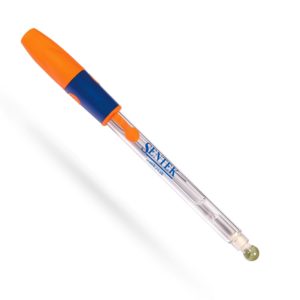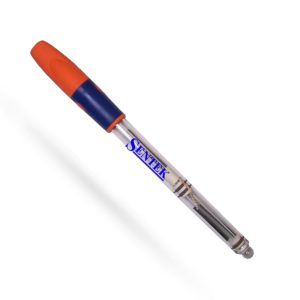Shop Electrodes by Application
Our products can be used in a wide range of applications. Our electrodes are manufactured accurately with first-class engineering and are ideal for quality results in various applications.
When it comes to choosing pH electrodes, each one performs differently based on the sample and application conditions. pH electrodes come in a range of shapes and sizes, and with a variety of features which can be useful for different applications. Here is a guide to selecting the right pH electrode to meet the needs of your application.
pH electrodes are of the most common laboratory tools for measuring how alkaline or acidic a substance is. This probe measures the ratio of hydrogen ions (H+) to hydroxyl ions (OH-) to determine the pH level of a solution.
The main features to consider when finding the right pH electrode for your applications are the following:
Combination electrodes combine a sensing electrode and reference electrode into one body. They are the most common design, as it is much easier to use than two separate sensors. In some rare applications, half-cell sensors are advised – such as if the sample is particularly hash/ aggressive and the pH sensing part of the sensor is likely to have a reduced lifespan compared with the reference.
The material of the main shaft of the sensor. The most common materials used are glass or epoxy. Glass bodied electrodes are typically used in samples containing proteins, organics, some solvents and mediums that would attach an epoxy body. The epoxy bodied electrodes tend to be more economical, are more durable, and can also be used in situations where the medium has the potential to attack and etch glass. Glass is able to withstand higher temperatures than epoxy. For industrial applications Ryton® polyphenylene sulfide (PPS) is used due to its exceptional dimensional stability and ability to withstand prolonged, high temperatures. It is also inherently flame retardant and offers chemical resistance comparable to PEEK and fluoropolymers.
This part of the probe creates an electrical contact between the reference and the solution being measured. There are several types of material used for junctions; ceramics are the most common, it offers a low leak rate that is suitable for liquid filled sensors. Teflon is another option which is easy to handle and clean.
pH electrodes can either come in single or double junction designs. Single junctions put the reference electrode in direct contact with the sample. They cost less but are more prone to contamination. Double junctions keep the reference isolated from the sample through the use of two chambers. They offer an extra barrier of protection to the reference, which can prolong lifespan and is favourable in applications where silver salts are likely to cause a problem.

P15 – Single Junction Electrode

PI10 – Double Junction Electrode
The membrane is the pH sensitive glass part of the sensor, which is connected to the end of the shaft. Membranes can come in a range of shapes depending on the application; bulb shapes for general applications and high accuracy, rods for applications that require a more sturdy or robust membrane, flat tipped for surface measurements, spears for penetrating soft solids.
The most common type of reference is Ag/AgCl, which is generally acceptable for most common applications. It gives a stable and reliable reading. Calomel (HgCl) electrodes are also popular, but since they contain mercury, they are used less often in modern times.
Many sensors have the option to have a temperature sensor integrated into the electrode. Since pH is dependent upon temperature, an accurate measurement requires temperature compensation, to ensure an accurate measurement is made. Manual temperature compensation is also available on many instruments, or separate temperature probes (non-integrated) are also available.
Most standard Sentek sensors have a shaft length of 120mm, and 12mm outer diameter, however sensors come in all shapes and sizes so it is important to consider physical requirements when selecting a pH electrode for your application. We can offer very small diameter sensors for micro-applications, or industrial style electrodes with thread to screw into a pipeline. We can also modify immersion depth if the application has specific requirements.
Most laboratory style sensors come with 1 meter cable as standard, and industrial electrodes with 5 meters. This can be customised on request.
The connector type will depend on the instrument that the pH electrode will be connected to. The most common type of connector is a BNC, however many others are available for most instruments.
If above 12, a special type of glass is required to minimise the error caused by sodium ions.
Some electrodes are able to withstand high pressure and/or temperature, due to the addition of pressure compensation inserts, salt rings and other features that ensure a higher rating for these features.
Sensors that are liquid filled are refillable, which is beneficial for some applications in which the electrolyte may become contaminated or the concentration is likely to change quickly. Although it is not recommended to store pH electrodes dry, we do offer some sensors that are filled with our Dry Tech Gel formulation, which is designed for convenient storage without drying out. We can also offer a range of customised electrolyte formulations, if there are certain chemicals are incompatible with your sample. We have a special ‘non-aqueous’ formulation which is designed for use on samples such as biofuels or samples with high alcohol content.
There are a variety of pH sensor designs out there that can work with a range of applications. For example, when testing meat, a spear shaped membrane is recommended in order to penetrate the sample, without causing damage to the glass.
If an application requires steam-sterilisation, we can offer an autoclavable sensor, which has pressure compensation and is gel filled with an airgap to allow for expansion of the internal electrolyte. This means that the sensor can be used in a range of biotech, food, beverage and pharmaceutical applications, as it can be completely sterilised between each use.
For non-aqueous applications, we can offer a refillable double junction electrode. This allows the user to replace the electrolyte with our non-aqueous formulation.
Pharmaceutical and laboratory applications often require high accuracy measurements. For these applications, the best solution is a bulb shape membrane to ensure a fast and accurate reading. To ensure a very stable measurement, an Ag/AgCl cartridge can be used instead of an Ag/AgCl wire, as this will improve accuracy and lifespan of the sensor.
For many applications, a surface measurement is required. Sentek’s P17 has a flat membrane which can be pressed against the surface, and a teflon junction that will be resistant to blockage from the sample.
For low conductivity and high purity water applications, we have a special glass membrane which is more suited to these conditions, and a liquid electrolyte to ensure a flow through the junction.
In industrial applications, sensors which are able to withstand higher temperatures or pressure are often required. This is achieved through the addition of salt rings to maintain electrolyte concentration, pressure compensation inserts in the pH and/or reference chambers, and use of sealants that are able to withstand higher pressure and temperature conditions. We can customise sensors to be threaded for insertion into pipelines. A range of thread sizes are also available, including PG13.5 and ¾” NPT.
Here at Sentek we make a wide range of probes that you can order online. To find out more about our range of pH probes, please get in touch with us today.
Copyright 2024 Sentek Limited. All Rights Reserved.
Marketing by Unity Online